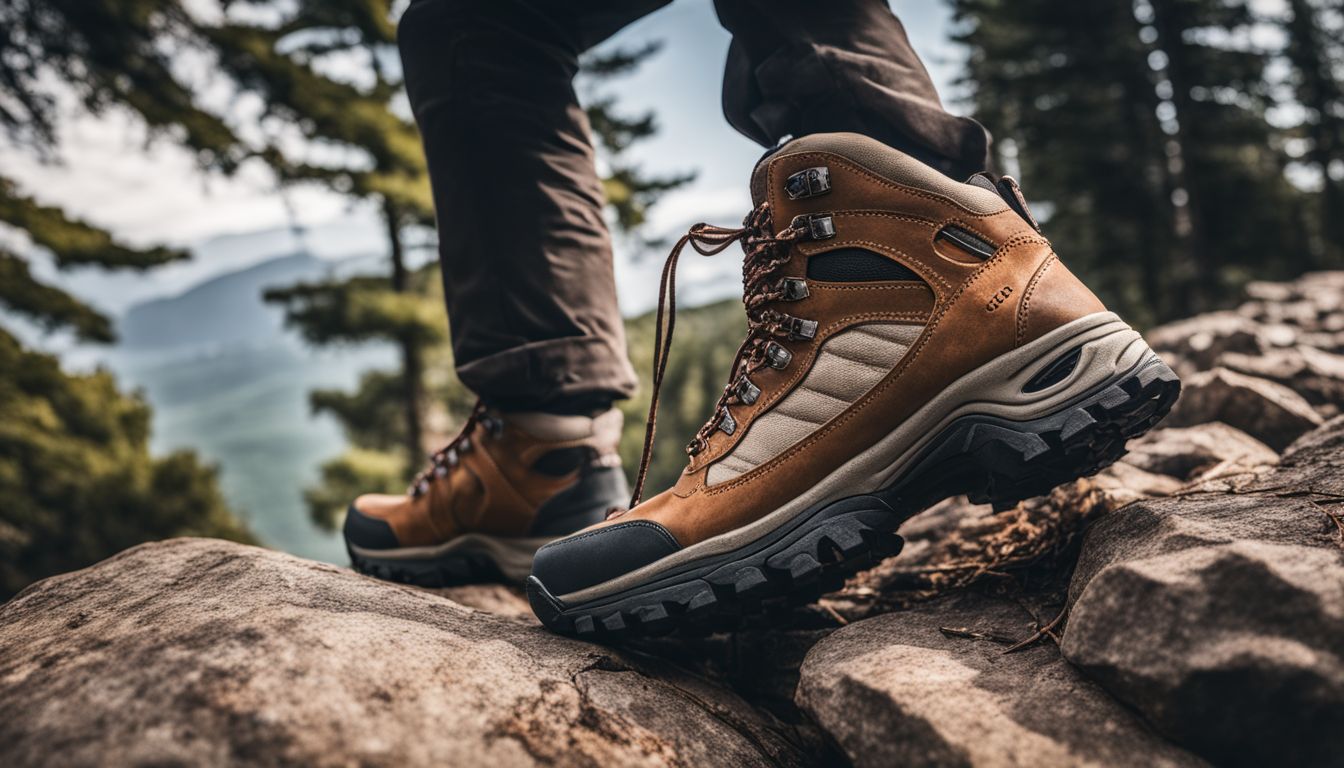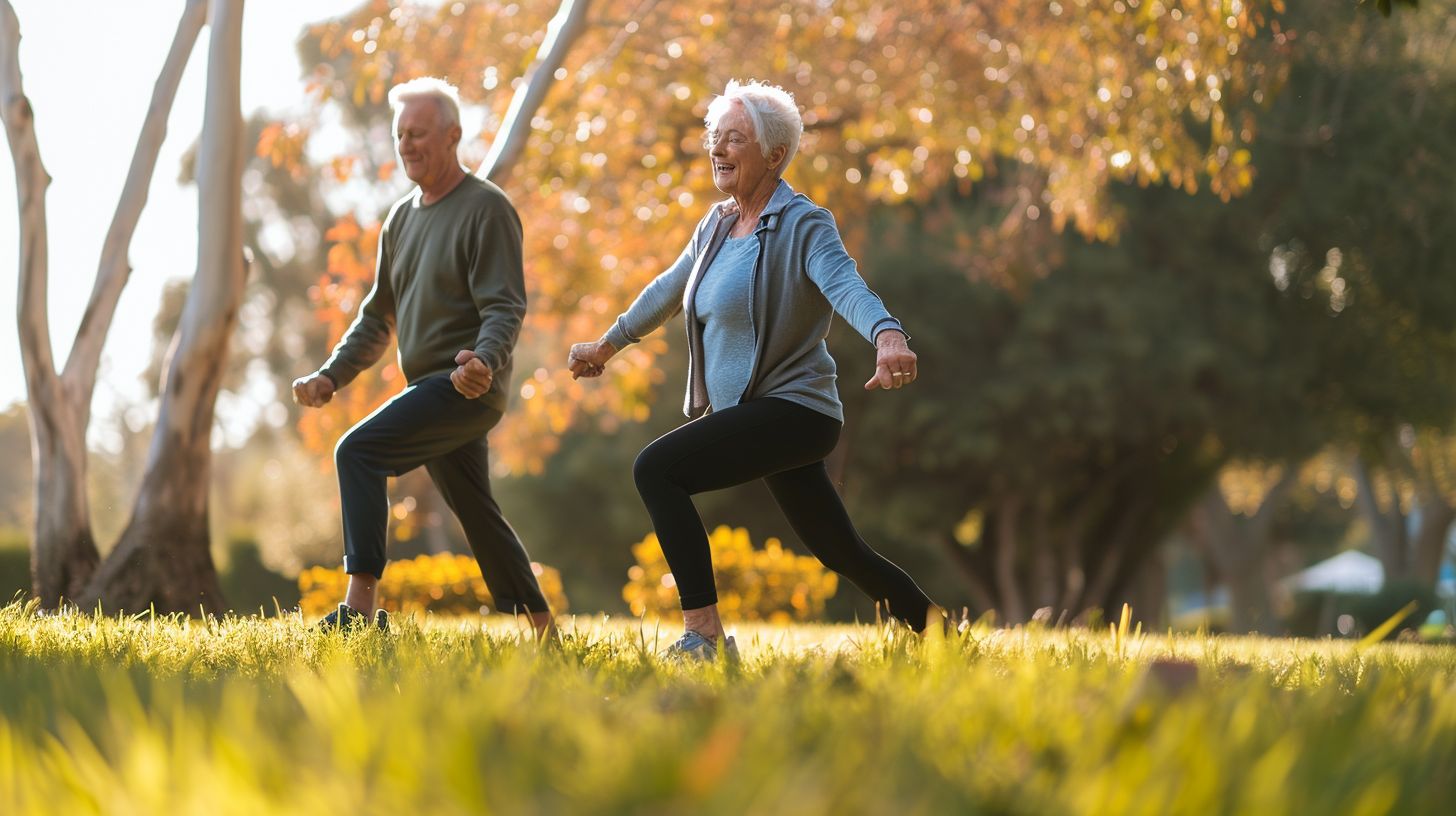Navigating through your golden years, you may find that keeping steady on your feet is becoming a bit more challenging. Ankle stability is key to avoiding those unwanted trips and falls.
This article offers simple exercises to boost ankle strength and mobility, giving you the confidence to walk tall and safely. Let’s step up to better balance!
Key Takeaways
- Strong ankles help seniors avoid falls and stay mobile. Simple exercises like toe raises, heel lifts, and ankle circles can be done at home to improve strength.
- Ankle stability exercises should include movements that enhance balance like one-leg balances and tandem walks which challenge the muscles more than regular walking.
- It’s important for seniors to practice these exercises regularly for the best results. Consistency leads to better flexibility, less pain, and improved overall movement in daily activities.
- Safety is key when doing ankle exercises. Wearing proper shoes, warming up before starting, staying hydrated, and listening to your body can prevent injuries.
- Advanced moves like Single Leg Stance upgrades are great for those ready to level up their exercise routine. They provide a higher challenge but lead to greater mobility and reduced risk of falls.
Importance of Ankle Stability for Seniors

Strong ankles help seniors stay active and avoid falls. Good ankle stability means better balance, so you’re less likely to trip or stumble. As we age, our muscles get weaker. This includes the ones around your ankles.
With strong muscles, you can move more easily and keep doing the things you love.
Ankles that don’t wobble make walking safer and more comfortable. For seniors dealing with arthritis or diabetes, solid ankles are even more important. These health issues can mess with your balance, but if your ankles are sturdy, it’s like having a built-in support system for your whole body.
Key Exercises for Strengthening Ankles

For seniors aiming to step up their game in ankle health, we’ve got a prime lineup of exercises designed specifically for strengthening those vital joints. No need for fancy equipment; these moves hinge on simplicity and effectiveness—just what’s needed to keep you striding forward with confidence.
Toe Raise, Point, & Curl
Toe Raise, Point, & Curl exercises are great for your feet and toes. They boost flexibility and can be done while you sit down.
- First, find a sturdy chair and take a seat. Make sure your back is straight and feet are flat on the floor.
- Slowly lift your heels, keeping your toes on the ground. This is the “Toe Raise.”
- Hold that position for a few seconds, then lower your heels back down.
- Now, lift your toes up while keeping the heels planted. This move is called “Point.”
- After holding the Point position briefly, lower your toes back to the floor.
- Lastly, curl your toes inward as if you are trying to grab something with them. This is the “Curl.”
- Try to do each of these moves 10 times.
- Rest for a moment between sets if you need to.
- You can do this exercise every day to help keep your ankles strong.
Achilles Stretch
Strong ankles help you move better and avoid falls. The Achilles stretch can keep your ankles flexible.
- Stand arm’s length from a wall.
- Place your right foot behind you, keeping it flat on the floor.
- Make sure your heel stays down and your toes point straight ahead.
- Lean into the wall as you bend your left knee slightly.
- Hold this pose for 15 – 30 seconds, feeling a stretch in your right calf.
- Switch legs and repeat the stretch for balance.
Ankle Circles
Ankle circles are a great way to boost flexibility and motion in your ankles. They’re simple, effective, and you can do them anywhere. Here’s how to perform ankle circles the right way:
- Sit down or stand up straight to get ready for your exercise.
- Lift one foot off the ground just a bit.
- Slowly rotate your lifted foot, making large circles with your toes.
- Imagine drawing a big circle with your big toe as you move your foot clockwise.
- Keep going for about 10 to 15 seconds then switch directions.
- Now, make those circles go counterclockwise for another 10 to 15 seconds.
- Place that foot back on the floor and give the other foot a turn.
- With each rotation, try to push a little further without causing pain.
- Do these ankle exercises every other day as part of your routine.
One-Leg Balance
After loosening your ankles with circles, it’s time to build stability with the one-leg balance. This exercise improves your balance and strengthens the muscles around your ankle.
- Stand near a chair or counter so you can steady yourself if needed.
- Plant one foot firmly on the ground.
- Slowly lift your other leg off the floor, bending at the knee.
- Hold this position for as long as you can, aim for 10 – 30 seconds.
- Keep your raised foot close to your standing leg, don’t let it stick out to the side.
- Focus on a fixed point in front of you to help keep your balance.
- Switch legs after each hold and repeat the exercise.
- Try not to sway too much; keep your hips steady.
- As you get better, try closing your eyes for more challenges.
Standing Heel Lifts
Standing heel lifts are a great way to strengthen not only your ankles but also your knees and quads. This exercise is easy to do and can be a helpful addition to your daily routine.
- Stand straight with your feet shoulder-width apart. Make sure you’re on a flat surface for balance.
- Place your hands on the back of a chair or against a wall for support.
- Slowly rise onto your tiptoes, lifting both heels off the ground. Imagine you’re trying to reach something high above you.
- Hold this position for a count of three, keeping your body tall and straight.
- Carefully lower your heels back down to the floor. Do it gently — don’t let them drop.
- Repeat this movement 10 times, aiming to go higher on your tiptoes each time.
- Rest for a minute, then do another set of 10 lifts. As you get stronger, try adding more sets.
Exercises to Improve Ankle Mobility

As we age, our ankles can become as stiff as a frozen turkey on Thanksgiving morning—no fun for anyone! To get those joints moving again, it’s crucial to integrate exercises that not only strengthen but also enhance the range of motion; think of them as your ankle’s personal yoga retreat, where flexibility and fluidity are the VIP guests.
Toe-Heel Walks
Toe-heel walks boost ankle stability and mobility. They can be an easy part of your daily routine. Here’s how to do toe-heel walks:
- Start by standing up straight with your feet hip-width apart.
- Lift onto your tiptoes as if reaching for something high, then slowly lower down to a flat foot.
- Next, roll onto your heels, lifting your toes off the ground.
- Take a step forward, landing first on your heel, then rolling forward onto your toes.
- Repeat this movement, walking across the room on an imagined tightrope.
- Focus on smooth transitions from toe to heel as you walk.
- Use a wall or chair for support if you need help balancing.
- Aim to walk for at least two minutes or until you feel steady and comfortable.
Lunges
After mastering toe-heel walks, lunges are your next step to boost ankle stability. They’re great for strengthening your lower legs and helping with your range of motion. Here’s how to add lunges to your routine:
- Start with your feet shoulder-width apart and hands on hips.
- Step forward with one leg, bending the knee until it’s above the foot.
- Keep the back leg straight and heel off the ground.
- Push up through the front foot’s heel to return to the starting position.
- Repeat this movement 10 times before switching legs.
- Focus on keeping balance; don’t let the knee wobble.
- Align the front knee with the second toe to avoid strain.
- If needed, hold onto a chair or wall for extra support.
- Lunges are about quality over quantity; better to do a few good ones than many poor ones.
- Listen to your body—if something hurts in a bad way, stop and rest.
- Aim for at least five minutes of lunges every day for best results.
Toe Extensions
Toe extensions are a great way to boost your ankle mobility. These moves can help ease issues like plantar fasciitis and keep your feet feeling strong.
- Sit in a comfortable chair with both feet flat on the ground.
- Lift one foot and rest it on the opposite thigh.
- With your hand, gently push back all of your toes toward your shin.
- Hold this position for 15 to 30 seconds.
- Next, focus on pushing just the big toe back toward the shin while keeping the other toes straight.
- Then switch it up by pressing only the baby toe back and keeping the others straight.
- Make sure you repeat these stretches with both feet.
- Do this routine two to three times a day for best results.
Sand Walking
Switching from toe extensions to sand walking offers a refreshing change in your exercise routine. Sand walking is not just a walk on the beach; it’s a powerful activity for seniors aiming to strengthen their ankles.
- The soft, uneven surface of sand challenges your muscles and joints.
- As you step, the sand shifts, making your foot and ankle muscles work harder.
- This extra effort boosts strength in key areas that help prevent falls.
- Walking on sand also engages your core muscles, which helps improve overall balance and stability.
- Plus, the gentle resistance of sand can increase mobility in your ankles without putting too much strain on them.
- Regular sand walks can lead to better posture and coordination during daily activities.
- The activity promotes blood circulation, aiding in faster recovery from ankle injuries or surgeries.
- Since walking on sand requires more energy than walking on hard surfaces, it can help manage obesity by burning more calories.
- For those who may experience crampy calves or have trouble with their achilles tendon, sand walking provides a low-impact alternative to high-intensity exercises.
- Additionally, the sensation of sand underfoot can be soothing for neuropathy sufferers who deal with tingling sensations in their feet.
Advanced Ankle Stability Exercises

For those ready to take their ankle stability up a notch, we’ve got some challenging moves that can seriously enhance balance and strength. Think of it as leveling up in a game where the prize is better mobility and less risk of falls — advanced exercises like Single Leg Stance upgrades are your next frontier in staying active and sure-footed.
Single Leg Stance (SLS)
Single Leg Stance, or SLS, is a great way to boost ankle stability. It’s especially good for seniors who want to walk without pain.
- Stand straight with your feet hip-width apart. Find something still to look at.
- Lift one foot slightly off the ground. Hold onto a chair if you need it.
- Keep your lifted foot close, but don’t let it touch the other leg.
- Balance on one foot as long as you can, aiming for 30 seconds.
- Switch legs after a short break and repeat the exercise.
- Try this every other day. It helps stop ankle discomfort.
- Let go of any support slowly and try balancing without help.
- Focus on keeping your standing leg strong and straight but not locked.
- Breathe evenly while doing SLS; don’t hold your breath.
- Always wear comfortable shoes that support your feet well.
- Make sure the area around you is clear so you won’t trip if you lose balance.
- If you start feeling dizzy or unstable, sit down right away.
Forward SLS
Strong ankles are vital for seniors to move and stay balanced. Forward SLS, or Single Leg Stance, helps build that strength.
- Find a stable surface to hold onto, like a chair or countertop.
- Stand straight with your feet hip-width apart.
- Shift your weight onto one foot.
- Slowly lift the other foot off the ground.
- Keep your lifted leg close, but don’t let it touch the standing leg.
- Hold this position for up to 30 seconds.
- Lower your foot back down gently.
- Focus on something still to keep your balance.
- Breathe steadily while you stand on one leg.
- Do the same number of repetitions with each leg.
- Wear non-slip shoes to prevent sliding during the exercise.
- If you feel dizzy or unstable, stop right away.
Forward Reach SLS
Forward Reach SLS is a great exercise for seniors to boost ankle stability. It helps prevent falls and improves balance.
- Stand behind a sturdy chair that you can hold onto if needed.
- Lift one foot slightly off the ground, keeping your other leg straight.
- Slowly hinge forward at the hips, reaching your hands towards the front.
- Keep your back flat and avoid bending at the waist too much.
- Reach as far as you can while maintaining control and balance.
- Hold this position for a few seconds then return to standing up straight.
- Switch legs and repeat the exercise with the other ankle.
- Aim for 5 to 10 repetitions on each side.
Tandem Walk
Moving from the forward reach in a single-leg stance, let’s shift our focus to tandem walking. This advanced move is a giant leap toward stronger ankles and better balance.
- Start by standing straight and placing your hands on your hips for extra stability.
- Step forward with one foot, placing the heel of that foot directly in front of the toes of your other foot, as if you’re walking on a tightrope.
- Focus your eyes on a fixed point in front to help keep your balance.
- Walk heel-to-toe for about 15 to 20 steps, then turn around and go back.
- Repeat this exercise two or three times to get the full benefit.
- Take it slow at first and use a wall or chair for support if needed.
- As you get better at tandem walks, try doing them without holding on to anything.
Health & Safety Tips for Ankle Exercises
Staying safe during ankle exercises helps you avoid injuries. Keep these tips in mind to protect your ankles.
– Warm up before starting any exercise by doing gentle stretches or a brisk walk; this prepares the muscles and joints.
– Wear supportive shoes that provide a stable base, especially if you have conditions like bunions or heel spurs.
– Start slow with new exercises; give your body time to adjust and prevent overdoing it.
– Pay attention to pain—if an exercise causes discomfort, stop immediately and consult a healthcare provider if necessary.
– Stay hydrated throughout your workout to keep muscles working well and reduce cramp risk.
– Ensure good form by using a mirror or having someone check your posture during exercises like lunges and heel lifts.
Conclusion
You’ve learned some top exercises to make your ankles strong and flexible. Remember, keeping those ankles in shape means you can walk, dance, and play with ease. Mix up these moves and stay steady on your feet.
Give them a try – your ankles will thank you! Keep moving; it’s the key to staying active and healthy as we age.
FAQs
1. What are the best exercises for seniors to improve ankle stability?
Standing calf raises and toe-walking strengthen muscles, helping with balance disorders often faced by seniors. Experts recommend these exercises for better support around the ankle joints.
2. How can a tennis ball help prevent ankle injuries?
Rolling a tennis ball underfoot massages your arch, easing knots and relieving pain in soft tissue injuries. This simple method can enhance blood flow and reduce cramps.
3. Should I get my ankles checked if I’ve had sprains before?
Yes, getting regular physical examinations is smart! A check-up uncovers hidden problems like tendinitis or fractures so you can take action before they worsen.
4. Can wearing high heels really affect my ankles as I get older?
High heels shift pressure to your second toes, straining flexors – that’s bad news for ankle health over time! Instead, go for orthopedic shoes that provide comfort and fend off pes planus (flat feet).
5. Why is vitamin D important for maintaining healthy ankles in seniors?
Vitamin D keeps bones strong – crucial when you’re at risk of brittle bones or want to avoid chronic issues like osteoporosis which could lead to falls causing serious injury.
6. What should I do if my ankles feel weak after exercising them?
After working those dorsiflexion and plantarflexion moves; rest up! Going to sleep lets your body recover from activities that push your limits.





